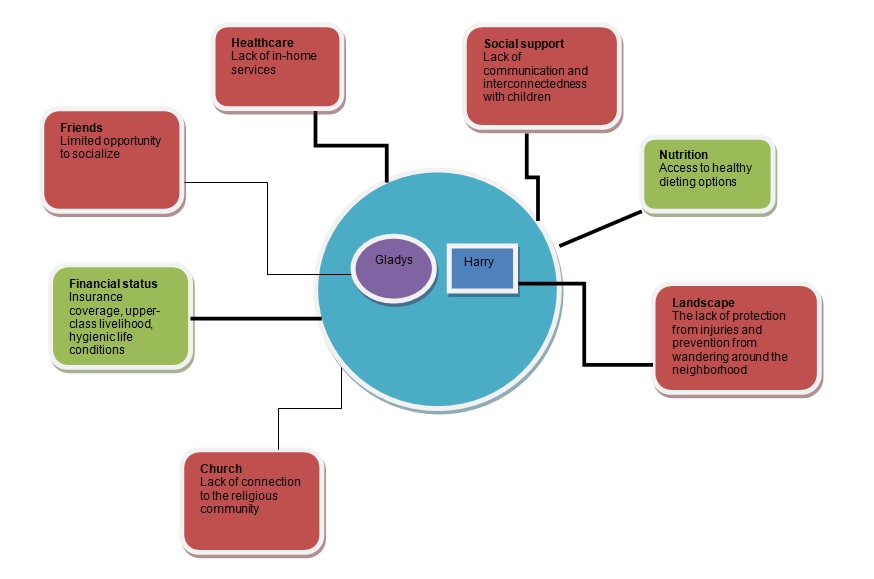Key Points of Therapeutic Conversation
A therapeutic conversation is meant to identify communication needs of family members and encourage them to express feelings. Not only does it help to develop more targeted and age-appropriate intervention strategies but also allows rendering necessary psychological support to patients through the practice of active listening. Additional questions, which a nurse may ask during the conversation, are as follows: What is the current stage of interconnectedness among family members? What are the primary sources of anxiety and fear? Which factors interfere with changing the adverse situations? Which cultural, social, and spiritual resources could help improve the current condition?
Identifying Data
The spouses, Harry and Gladys, are over 65 years old, while four of their adult children are in the age group of 35-65 years old. While Gladys is now in relatively good health and suffers only from mild forms of hypertension and depression, Harry’s health is frail since he has Alzheimer’s disease. It means he is highly dependent on others. The family is financially secured and lives in an upper-class neighborhood. The spouses’ children do not live with them and rarely visit yet continue to maintain some contact with their parents via phone. Thus, the elderly family members do not have any direct source of social support except Gladys’ friends with whom she continues to meet once in a while. Harry and Gladys are Catholics, but they do not go to church anymore due to the husband’s progressing mental confusion associated with his disease.
Developmental Stage and History of Family
The spouses are in the late developmental stage. According to Newman and Newman (2017), psychological crises and significant sensory changes are typical for elderhood. Gladys’s declining vision is an example of such changes. Additionally, her depression may also be partly defined by her age because people of advanced age need to have more rest throughout the day and good sleep during the night instead of being stressed by a plethora of responsibilities. The transformations that naturally happen in the body due to age require compensation through the modification of the environment and behaviors. To adjust to bodily changes effectively, it is important to understand the family history and genetic risks. The main health problems in the selected family include Alzheimer’s disease and stroke. Currently, Gladys is at high risk of stroke due to her hypertension. Additionally, Gladys and her daughter, Mabel, have depression ̶ the mental condition that has both environmental and genetic determinants (Dunn et al., 2015). Thus, it is important for all family members to modify their fitness, sleep, rest, nutritional, and social intercourse patterns to improve their quality of life and health outcomes. Considering that Gladys’s mother was centenarian and died due to natural causes, there is a high chance for the family members to live a long and healthy life.
Environmental Data
The community where Gladys and Harry live is upscale and relatively safe. It is clear that the family has access to healthy food, and undertakes significant efforts to keep the house clean and well-maintained: Gladys uses a gardener’s services, regularly pays the bills, and cleans the house by herself. However, some hazards to Harry’s well-being are present in the environment. They mainly relate to landscape features, including the lack of a fence around the backyard pool and a lot of open space in the nearby area. These hazards increase the risk of injury and make it difficult to control Harry’s movement when he is in a delirious state of mind. Additionally, the absence of in-home support services interferes with Gladys’s ability to lead a healthier lifestyle: she is constantly deprived of sleep and does not have enough time to eat well, socialize, and exercise.
Family Composition, Structure, and Functions
At the present moment, the nuclear family comprises five individuals. Harry and Gladys are the parents with three adult children: Jim, Tim, and Mable. Marly was Mable’s identical twin that died in a car accident. It means that the family in the case study has a traditional structure. At the same time, the structures of the grown children’s families vary. Mabel has a childless family, Tim has a nuclear family, and Jim is currently divorced and has a child who lives with his former wife. As for the functions of the family members, Gladys plays a role of the primary decision-maker. She performs a wide range of responsibilities, including housework, cooking, and caring for Harry who requires assistance in carrying out even minor daily routines. Their children are mainly preoccupied with taking care of their own families and careers and, due to different reasons, do not provide enough psychological and social support for their elderly parents and do not participate in their life actively.
Family Stress and Coping
The lack of sufficient social support decreases Gladys’s ability to cope with stress well. At the same time, “social support plays a direct role in promoting health, well-being, and life satisfaction even when a person is not facing a specific stressful situation” (Newman & Newman, 2017, p. 595). Usually, she would socialize when playing bridge with friends and visiting the church, but the opportunities for engaging in these activities are decreasing along with the deterioration of Harry’s health. Other family members have some problems with coping as well. For instance, Tim finds it difficult to accept his father’s current condition, while Mable suffers from depression because of her identical twin’s death. Stronger spiritual, social, and cultural connections can help them improve psycho-emotional resilience and overcome anxiety and fears about death.
Eco-Map

References
Dunn, E. C., Brown, R. C., Dai, Y., Rosand, J., Nugent, N. R., Amstadter, A. B., & Smoller, J. W. (2015). Genetic determinants of depression: Recent findings and future directions. Harvard Review of Psychiatry, 23(1), 1-18.
Newman, B. M., & Newman, P. R. (2017). Development through life: A psychosocial approach. Boston, MA: Cengage Learning.